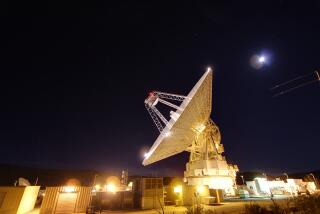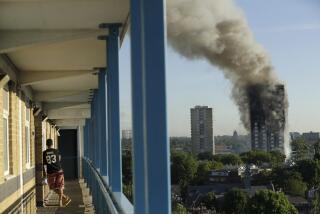Shuttle Report Misses Mark on Safety, Experts Contend
WASHINGTON — The government’s investigation of the Columbia accident has been widely praised by the White House, members of Congress and even top NASA officials, who say the final report succeeded beyond expectations in unraveling the technical mystery of what caused the space shuttle to break up.
But one of the report’s broader conclusions -- that the space shuttle “is not inherently unsafe” -- has prompted criticism from a chorus of engineers and space experts, who say that two fatal accidents and dozens of nearly catastrophic close calls show that the spacecraft is unreliable.
“I believe the shuttle is inherently unsafe,” retired NASA mathematician and rocket engine expert Jud Lovingood said this week. “We have proven that and there are more problems waiting to jump out. It is too complex. It is 1970s technology.”
Lovingood’s view was widely endorsed in interviews with members of Congress, space policy experts and space engineers.
Moreover, the 248-page report appears to be contradictory on the issue of the shuttle’s safety. In at least 15 different passages, the report describes the shuttle as “inherently risky,” “inherently vulnerable” and “highly risky.” It recounts compromises in the original design of the shuttle and in the budget that NASA was provided to operate it.
Whether the shuttle is basically safe or unsafe is one of the most important determinations that the Columbia Accident Investigation Board needed to make, as the nation begins to consider the space program’s future and whether to continue operating the shuttle, space policy experts say.
“The board should have been more direct,” said Paul Czysz, professor emeritus of aerospace and mechanical engineering at St. Louis University and a NASA consultant.
The contradictions within the report released Tuesday could muddy the debate that will start next week as Congress begins to hold hearings. At a news conference Tuesday, accident board chairman Harold Gehman Jr. reiterated several times the panel’s conclusion that the shuttle “is not inherently unsafe.”
Gehman did not respond to requests for an interview. A spokeswoman for the board said Gehman does not want to debate the merits of the report.
Board member Douglas Osheroff, a Nobel Prize-winning physicist at Stanford University, expressed a somewhat different view.
“Look, I don’t like the term that it is not inherently unsafe,” he said in an interview, adding: “It is not very safe.”
When asked on what basis the board reached its conclusion, he said, “I don’t know, but the failure rate of the shuttle is lower than it is for unmanned launch vehicles.”
Nonetheless, Osheroff said that the Feb. 1 Columbia and 1986 Challenger disasters were avoidable and that they were the product of NASA’s breakdown in procedures.
House and Senate committees on space will begin conducting hearings early next week to examine the report and consider where the nation’s space program should be headed. But even on this issue, some experts are critical of the accident board’s work as a backdrop for the debate.
“The report did not go far enough in addressing the nation’s rationale for the space program,” said Louis Friedman, executive director of the Planetary Society, a space exploration advocacy group. “They did not address that part of the problem, which they are now part of.”
The report made 29 recommendations, 15 of which must be implemented before the shuttle returns to flight. But the plan lays out what could be a very costly long-term program to upgrade the shuttle, and so far many members of Congress are unwilling to commit to a big spending plan.
Rep. Dana Rohrabacher (R-Huntington Beach), chairman of the House subcommittee on aeronautics and space, said he plans to begin hearings next month to examine the accident board’s conclusions and the future of the space program.
Rohrabacher also takes a dimmer view of the shuttle’s safety than the board does, but he praised Gehman’s work and said he believes NASA’s deeply flawed culture, rather than inadequate funding by Congress, was at the root of the Columbia tragedy.
But some outside critics also take sharp exception to the board’s emphasis on NASA’s culture as a cause of the accident. Blaming the agency’s culture casts responsibility on a vague concept rather than on the errors of individuals, the lack of technological expertise in the space agency and the failure by Congress to provide funds after NASA leaders warned that safety was deteriorating.
“Culture is amorphous,” said John Pike, executive director of the think tank GlobalSecurity.org. “Nobody owns a culture. Culture is the easy way out.”
Sheila Widnall, a board member and Massachusetts Institute of Technology engineering professor, said NASA’s management often did recognize safety problems and did act responsibly, but at other times it overlooked problems. Nonetheless, Widnall agrees that NASA is short of funds.
“I think there has been a resource problem from the very beginning of the shuttle program,” she said. “When we ran the foam tests, we got holy grief from NASA over the cost.”
Although nobody -- including NASA -- disputes that the agency’s culture needs to change, it is unclear that even with the best safety culture the technical cause of the Columbia accident could have been avoided.
NASA Administrator Sean O’Keefe pledged this week to make sweeping changes in the NASA culture but said he is “haunted” by the fact that outside safety experts and blue-ribbon panels failed to identify the foam debris problem when they examined the shuttle program.
The shuttle burned up during reentry over Texas, after foam debris had rammed the left wing and punched a hole in its delicate thermal protection system during launch.
O’Keefe said he is not certain that the accident could have been prevented even if all the improvements recommended by the accident board had been in place at the time of the flight.
NASA engineers had tried unsuccessfully for 20 years to fix the foam problem, while never realizing the full dangers posed by the debris. The foam was among any number of serious safety problems that NASA confronted, including such systems as the shuttle’s main engines, its auxiliary power units and its cockpit electronics. In many cases, the agency made improvements and in other cases its requests for funding were denied.
Indeed, O’Keefe said in an interview that Congress denied a NASA request for supplemental funding of $50 million for the shuttle after the Columbia accident. He estimated that it will require hundreds of millions of dollars in extra funding to get the shuttle flying again.
Some experts say it’s time to scrap the shuttle. That sentiment was expressed earlier this year by Max Faget, a principal designer of the shuttle.
“The bottom line is that the shuttle is too old,” Faget said. “We ought to just stop going into space until we get a good vehicle. If we aren’t willing to spend the money to do that, then we should be ashamed of ourselves.”
Charles Vick, a former NASA engineer and space analyst, goes further. He said that if the accident board had reached any conclusion other than that the shuttle is not inherently unsafe, then the fleet “would have been canned right then and there.”
“We just don’t have anything else,” Vick said. “We’re stuck with it.”
More to Read
Sign up for Essential California
The most important California stories and recommendations in your inbox every morning.
You may occasionally receive promotional content from the Los Angeles Times.











